Adam Brown is a conceptual artist working with scientists to create art pieces that use robotics, molecular chemistry, living systems and emerging technologies. Years ago, i saw one of his works at Emoção Art.ficial [Art.ficial Emotion], a Biennial of Art and Technology in Sao Paulo. The robotic sculpture, called Bion, explored the relationship between humans and artificial life. Fast forward to May 2013 when i am aimlessly clicking around and stumble upon one of his most recent pieces. This time, the project doesn’t use swarms of responsive synthetic “life-form” but bacteria that, over a period of one week, process the toxins of gold chloride and produce nuggets of 24-karat gold.
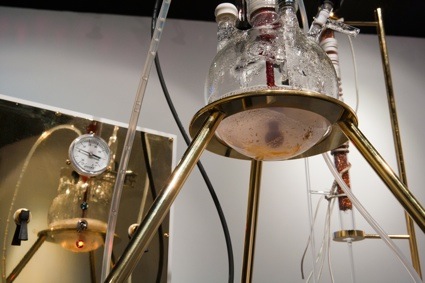 Adam Brown in collaboration with Kazem Kashefi, The Great Work of the Metal Lover, 2012
Adam Brown in collaboration with Kazem Kashefi, The Great Work of the Metal Lover, 2012
The Great Work of the Metal Lover earned Brown and his collaborator microbiologist Dr. Kazem Kashefi world-wide media coverage, an Honorary Mention at Ars Electronica as well as a Special mention at VIDA.
Brown brings together science and art into each of his works, from the initial concept up to the final realization. His artistic practice not only challenges scientific inquiry but it also comes with undeniable aesthetic qualities (something that is sometimes little more than a second thought in artworks that make use of the latest advances in science and technology.) Simply put, his artworks are beautiful to look at. While the Bion sculpture (below) is as stunning as it is smart, Origins of Life: Experiment #1.x (a working scientific experiment that builds on Miller-Urey’s 1953 experiment to draw attention to the artifice and aesthetics of experimentation) neatly hangs scientific instruments and processes on a wall as if they were museum paintings.
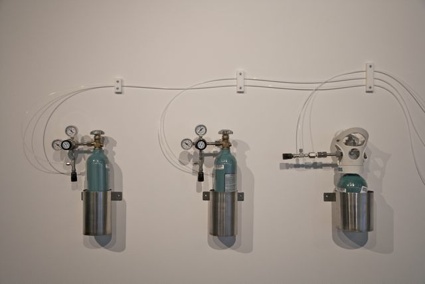 Adam Brown in collaboration with Robert Root-Bernstein, Origins of Life: Experiment #1.x (detail), 2010
Adam Brown in collaboration with Robert Root-Bernstein, Origins of Life: Experiment #1.x (detail), 2010
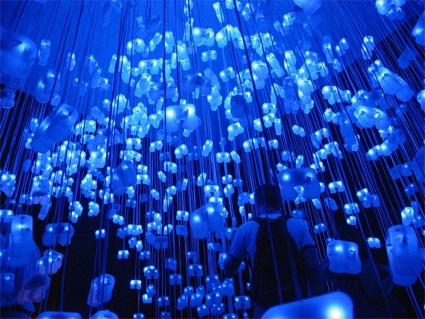 Adam Brown, in collaboration with Andrew Fagg, Bion, 2006-present
Adam Brown, in collaboration with Andrew Fagg, Bion, 2006-present
Brown is an Associate Professor at Michigan State University where he created the Electronic Art & Intermedia department. He is also a Research Fellow at the Institute for Digital Intermedia Arts at Ball State University, and serves as an Artist in Residence for the Michigan State University BEACON (Bio/Computational Evolution in Action Consortium) project.
I interviewed him via email just before he flew to Sydney to attend the ISEA Symposium on Electronic Art.
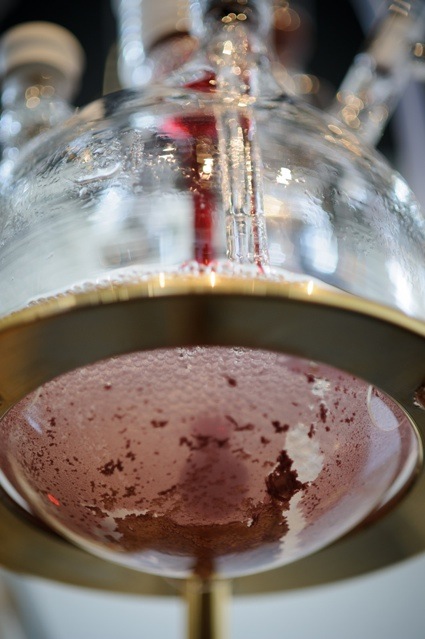 Adam Brown in collaboration with Kazem Kashefi, The Great Work of the Metal Lover, 2012
Adam Brown in collaboration with Kazem Kashefi, The Great Work of the Metal Lover, 2012
Hi Adam! What you’ve achieved sounds almost like a fantasy… Using bacteria to turn valueless material into gold. I’m sorry for the very mundane question but why don’t you make it a full time activity? You could be drinking cocktails on your yacht, on your way to a golf game with Donald Trump instead of answering my questions right now…
This is probably one of the most asked questions that I have received about this piece. The other question that is often asked is if I can share with people how to “make gold.” The potential to make gold and accumulate wealth is a very powerful motivator of the human condition. Even Forbes wrote about it. Fortunately, the process is not cost effective at this point. I have to buy the soluble form of gold I put into the reactor and, since the bacteria only grow in anaerobic conditions (no oxygen), I also have large expenses in creating the conditions for their growth.
Of course the natural follow up question is if it is possible to harvest the dissolved concentrations of gold in the oceans (which contain about 10 parts per million). It might be possible, but it would take a great deal of expense to scale up a system that would be efficient and cost effective. However, this is not something that I am interested in doing. What would be the environmental costs of engaging in such an activity? With our limited knowledge of the oceans ecosystem it is unclear what would happen to the ocean life if it were depleted of dissolved gold. As an artist, I’m more concerned with probing and questioning the potential impact of our ability to engineer and control nature.
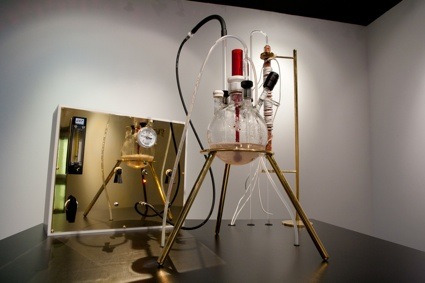 Adam Brown in collaboration with Kazem Kashefi, The Great Work of the Metal Lover, 2012
Adam Brown in collaboration with Kazem Kashefi, The Great Work of the Metal Lover, 2012
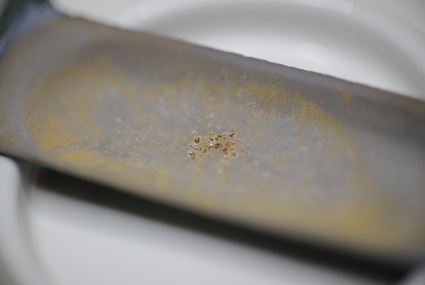 Gold flakes made by Adam Brown and Kazem Kashefi
Gold flakes made by Adam Brown and Kazem Kashefi
What brought you to alchemy? A nostalgia for an ancient quest or the mere curiosity to explore what an artist can do with modern microbiology?
Alchemy is a topic that I have been interested in for quite a long time. Alchemy incorporates both a spiritual, creative and scientific pursuit all in one. As an artist of the 21st century working with biological systems, alchemy feels like an appropriate model of reference.
At the height of Alchemy during the time of the European Renaissance the world appeared to be much less defined. Artists were at the same time engineers, architects, alchemists, chemists. It was possible for a single person to strive to be the universal person and have relatively deep knowledge of many fields. Of course times have changed, complexity has grown and specialization has become more necessary. Newer technologies including augmented memory and instantaneous access to information have changed the way artists work. Now instead of being the total person one can employ collaborative practice to venture into territories that were previously inaccessible. This changes the role of the artist to one more akin to manager or director.
I also like the poetics of possibly solving the ancient alchemical problem of the philosopher’s stone using modern microbiological science. Interestingly, the process does have some overlap to the description provided by alchemists describing the philosopher’s stone. One would know when they were getting close to transmuting base metals into gold because the solution would turn a redish/purple color called “rubedo.” The bioreactor of the GWML turns a purplish color when the microbial community is precipitating gold.
You developed the work in collaboration with Kazem Kashefi from the Department of Microbiology and Molecular Genetics at Michigan State University. What form did the collaboration take exactly? Was it you dictating what needs to be done and the scientist was executing your instructions. Or is the experience more hands-on from your part? With a more critical feedback from Dr Kashefi?
The relationship was hands on and mutualistic. One of my major interests is in origins of life research. This led me to extremophiles as they are probably some of the first forms of organized life on the planet and to Dr. Kashefi (Kaz). I read a paper he wrote in 2000 about how anaerobic extremophile microorganisms have the ability to precipitate heavy metals and even gold. I asked him if he thought it possible to devise a system capable of producing enough gold that one could hold in one’s hand. This was the beginning of the collaboration. Over the course of a year, Kaz and I conceptualized how to construct a sustained culture capable of this task. He taught me the lab bench practices to, culture, grow anaerobic microorganisms. I designed, conceptualized and built the installation; Kaz led the scientific inquiry but we practiced the science together.
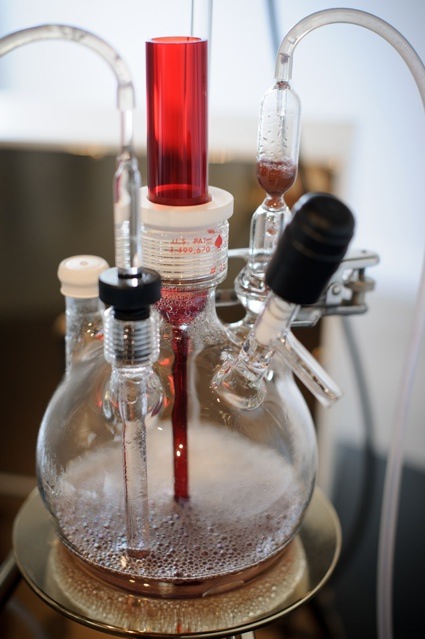 Adam Brown in collaboration with Kazem Kashefi, The Great Work of the Metal Lover, 2012
Adam Brown in collaboration with Kazem Kashefi, The Great Work of the Metal Lover, 2012
Unlike many works that merge art and science which outcome only appear in art publications, articles about The Great Work of the Metal Lover also appeared in science magazines. So what makes the piece appealing to the scientific community?
One of my goals as an artist, especially when it comes to collaboration is make work that has a high degree of mutuality between the respective disciplines. While it is not always the case, when working collaboratively I like to try to make contributions to the various fields of research that are represented. So, in this case, it is important to not only make contributions to the arts, but also to the sciences. The GWML does tap into interesting science in that we have shown that the microorganism is able to survive and even flourish on much higher concentrations of gold chloride than has ever been reported (ten fold in fact). Secondly, the research is relevant to scientists that are interested in the possibility of metabolic process being responsible for mineral production. Finally, novel uses of microbes, including genetically modified versions, are a hot topic for research at the moment; scientists are looking at biotechnologies to do everything from bioremediation, to microbial pharmaceuticals, to even energy production. Of course, gold does have a universal appeal, having been coveted by most people; scientists are not excluded from this bias.
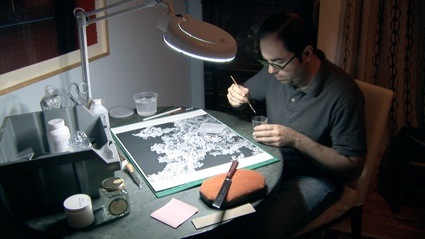 Adam Brown in collaboration with Kazem Kashefi, The Great Work of the Metal Lover, 2012
Adam Brown in collaboration with Kazem Kashefi, The Great Work of the Metal Lover, 2012
The artwork doesn’t stop at creating gold nuggets, it also features images made using a scanning electron microscope and an ancient gold illumination techniques. Could you explain us what the process involved and what the images represent?
The Scanning Electron Microscopic (SEM) images depict the microorganism Cupriavidus metallidurans creating the nanoparticles of gold within a biofilm. The prints function conceptually to provide objective proof that the claims of gold production are indeed authentic and act as a literal manifestation of combining ancient practice with modern scientific imaging. They also comment on scientific objectivity as well. Most images that we see made by an electron microscope are altered or enhanced in some way, usually using an application like Photoshop to add color and adjust contrast. The prints that I am producing are also enhanced. The only difference is that I am highlighting the location of the gold using the gold produced in the bioreactor in the image by adding gold to the surface of the print.
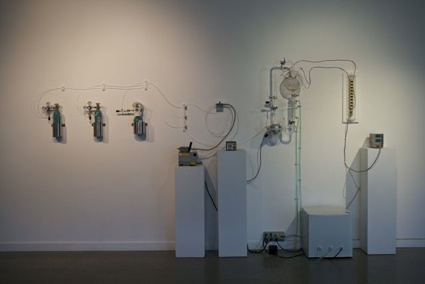 Adam Brown in collaboration with Robert Root-Bernstein, Origins of Life: Experiment #1.x, 2010
Adam Brown in collaboration with Robert Root-Bernstein, Origins of Life: Experiment #1.x, 2010
The description of the work Origins of Life: Experiment 1 opens on a quote by biologist E. O. Wilson “The aim of art is not to show how or why an effect is produced (that would be science) but literally to produce it.”
What is your understanding of the quote or how does the artwork illustrate it?
The quote illustrates a close alignment between art and science and that the practices are more connected then disconnected. The artist wishes to create a phenomenological output while the scientist’s main goal is to understand the phenomenon: a complementary/mutualistic relationship; an epistemological difference signifying that there are many more commonalities than differences. This once again ties into the discussion of the previous question about collaboration and mutualism. Origins of Life is an installation and a performative re-enactment of the Miller experiment that attempts to quite literally depict this relationship. It is in essence a contextual problem filled with an epistemological shifting perspective.
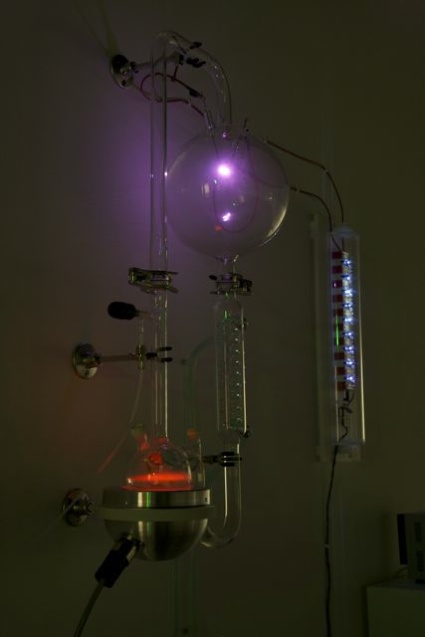 Adam Brown in collaboration with Robert Root-Bernstein, Origins of Life: Experiment #1.x, 2010
Adam Brown in collaboration with Robert Root-Bernstein, Origins of Life: Experiment #1.x, 2010
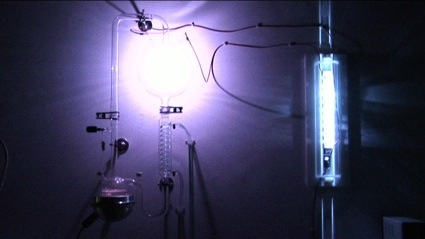 Adam Brown in collaboration with Robert Root-Bernstein, Origins of Life: Experiment #1.x, 2010
Adam Brown in collaboration with Robert Root-Bernstein, Origins of Life: Experiment #1.x, 2010
The Great Work can be summed up in a catchy headline, but Origins of Life cannot be reduced so easily to one sentence. Not everyone knows about the Miller-Urey experiment for example. So how do you manage to engage a scientific audience with an artwork and vice versa: how do you get the attention of art lovers with a work that deals with scientific theories?
True. Not everyone knows about the details of the Miller experiment, but big questions such as “where do we come from?” and “how did life begin?” have a much greater universal appeal overlapping with philosophy, religion, art and science. You don’t have to know anything about Miller-Urey or theories of how life originated to be fascinated by an apparatus that makes lightning and thunder, bubbles and boils, gleams and glistens and mysteriously converts a tank full of gas into brown-colored goo. Once interested, you can get the scientists to think about the artistic aspects of their practice and the artists to think about creating life as a metaphor for the creative process itself. The origins of life question is also what makes us human.
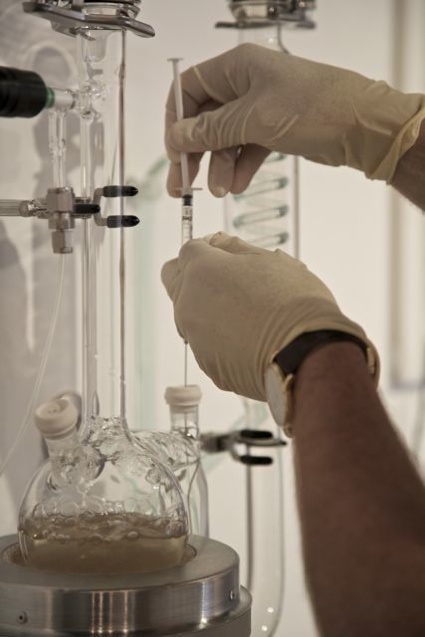 Adam Brown in collaboration with Robert Root-Bernstein, Origins of Life: Experiment #1.x, 2010
Adam Brown in collaboration with Robert Root-Bernstein, Origins of Life: Experiment #1.x, 2010
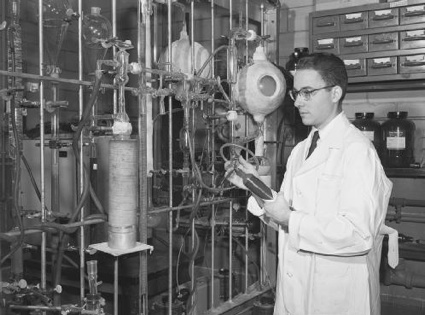 Stanley Miller working in the lab where he simulated atmospheric conditions similar to those on Earth 3.5 billion years ago and created organic compounds. © Bettmann/Corbis
Stanley Miller working in the lab where he simulated atmospheric conditions similar to those on Earth 3.5 billion years ago and created organic compounds. © Bettmann/Corbis
You also defined the project as being “open source”, as it ‘invites contributions and participation from other scientists.’ If find you very brave. not many artists would be comfortable with the idea. Why was it important to you to leave them this open door instead of keeping the project stable and immutable? Could you tell us how and if scientists have contributed or pushed it further and, more generally, how they have reacted to the work?
Once again, it goes back to the idea of collaborative practice and mutuality and started out as a collaboration with the scientist Robert Root-Bernstein. While it is important for me to have some conceptual ownership over the work, it is also important to attempt to solve the mystery of how life started on the earth. And technically, the original scientific experiment does not belong to me either as it is an appropriation from Miller. Are not the under-pinnings of the scientific method that of “open source”?
I have been interested in the Miller experiment since I was in high school. The original experiment enacted by Miller in 1953 never seemed to make much headway after the initial experiment; that is the production of amino acids from inorganic material. Perhaps this was a result of available technology of the time. When Miller died in 2008 I felt like it was an opportunity to continue with the project. There are many adaptations and further experiments that were never realized or maybe thought of: such as adding a phosphorus source like salt or even running the experiment for longer then a week. Since trying out some of these modifications we have synthesized Adenosine triphosphate (ATP) the power source of cellular life as well as a building block of DNA and also have shown evidence of the production of lipids which are the materials that make up cellular membranes.
Most scientists have been very positive about the project. They realize that scientific funding agencies are very conservative and can only fund what will obviously work. But what we already know will work doesn’t help us progress in our understanding. Engaging in the project as a performance lets us break out of the constraints that the scientific peer review system imposes so we can try the kinds of experiments most origins of life scientists would really like to try.
In fact, one scientist who had invented an ultra-sensitive ATP-measuring device, donated one to us so we could test whether we could make ATP along with amino acids. Overall, the scientific community has received the work very positively. Origins of life research in general has massive appeal. It is inspirational to scientists and artists both.
Any upcoming project, exhibition, areas of investigation you’d like to share with us?
I have a few projects in the works. I will definitely share them with you and We-Make-Money-Not-Art when they are ready to be released in the near future.
Yes, please! And thank you for your answers Adam.
